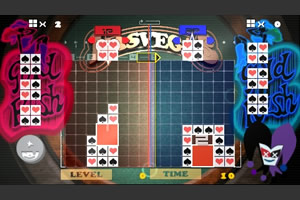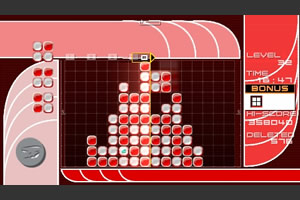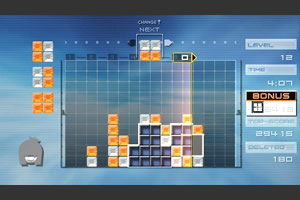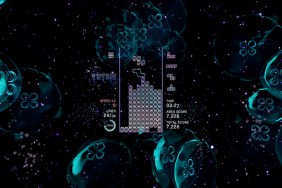A puzzle by any other name would play as sweet.
When I first tried to pick up Lumines at the store, I asked the clerk, “Do you have loo-min-ess?” The girl looked at me funny, turned around, and said “Ron, do we have any copies of loo-meens?” They were out, but a new question was already raised: how do you pronounce the title? Lum-in-ees? Loo-mee-nays? The more I thought about it, the more possibilities there were. The French would probably just pronounce it loom. Silly French.
GR editor extraordinaire Ben Silverman (not French) apparently agreed with the girl in the store, when he called me to ask, “Where’s your loo-meen review?” I had to get to the bottom of it.
While Ubisoft is indeed a French company, it turns out the game is pure Japanese. It was developed for Bandai by Tetsuya Mizuguchi, the man behind the critically-acclaimed Rez and the very creative and visually cool (although overhyped) Space Channel 5. Off I went to the official Japanese site for the truth, where, unfortunately, the title was still in English.
But right there underneath in crisp katakana was the Japanese spelling: ![]() . This would roughly be pronounced ru-mi-neh-su (the Japanese have a huge problem with the letters L and R, which they consider to be identical sounds). So, replace the R with an L, and the u sound in su is actually muted, and voila, we have our answer: loo-mi-nes.
. This would roughly be pronounced ru-mi-neh-su (the Japanese have a huge problem with the letters L and R, which they consider to be identical sounds). So, replace the R with an L, and the u sound in su is actually muted, and voila, we have our answer: loo-mi-nes.
Whew. That really puts my mind at ease. It also proves that I really should have better stuff to do with my time, like getting back to stacking the stylish, glowing, multi-colored squares of Lumines on my PSP.
Lumines is the latest in gravity-fed Tetris derivatives, and easily one of the best since Tetris itself first pierced the iron curtain back in 1987. Like all puzzle games of its ilk, Lumines is simple and addictive – your little sister will be able to pick it up and figure out how to play almost immediately.
Unlike Tetris, all the blocks are square, but each is subdivided into four independently moving smaller squares which are painted one of two colors. The goal is to stack together at least four smaller squares of identical color together. Once you have a solid group, the constantly left-to-right moving “Time Line” will pop those squares like a wiper blade, allowing the ones on top to fall down. Just like Tetris, the goal is to avoid stacking your blocks all the way to the top.
 Since you can rotate the squares, the math majors out there have already figured out that there are only six possible block combinations. Don’t let that simplicity fool you, though; while it’s possible to play and have fun right away, you’ll eventually discover deeper strategies. With a wide playing field and the ability to see the next three upcoming blocks, you’ll really need to start planning out some in-depth stacking strategies to do well. You don’t just get faster at Lumines, you get better.
Since you can rotate the squares, the math majors out there have already figured out that there are only six possible block combinations. Don’t let that simplicity fool you, though; while it’s possible to play and have fun right away, you’ll eventually discover deeper strategies. With a wide playing field and the ability to see the next three upcoming blocks, you’ll really need to start planning out some in-depth stacking strategies to do well. You don’t just get faster at Lumines, you get better.
Occasionally you’ll get a special square, which when popped takes with it all touching squares of the same color, regardless of whether they’re in a group of four or more. This can be a lifesaver and a big scorer if planned correctly.
Aside from the addictive gameplay, what Lumines really has in spades is style. Dozens of different skins give the identical game a whole new look and feel. From Edo-style samurai paintings to flashing spaceships to distracting dancing silhouettes, Lumines keeps your eyes flying. One skin even goes so far as to mimic an old monochrome LCD screen. Nice.
Your ears are given the royal treatment, too. Cool techno remixes grace the perfect block-popping sound effects. The music features tracks by Mondo Grosso and Eri Nobuchika, who I am led to believe are well known in the Japanese club scene. Be sure to wear your headphones while playing or you’re missing out on half the joy.
 While the gameplay remains the same throughout, there are a number of different modes. The main one is clearly Challenge Mode, where you play as long as you can and rack up high scores to unlock new skins. The later levels get nearly impossible and mix you up by not only increasing the speed at which blocks fall, but also altering the speed of the “Time Line.” The skins change occasionally in this mode, but always in the same order, so unfortunately you’ll get overly familiar with the first few skins.
While the gameplay remains the same throughout, there are a number of different modes. The main one is clearly Challenge Mode, where you play as long as you can and rack up high scores to unlock new skins. The later levels get nearly impossible and mix you up by not only increasing the speed at which blocks fall, but also altering the speed of the “Time Line.” The skins change occasionally in this mode, but always in the same order, so unfortunately you’ll get overly familiar with the first few skins.
Single Skin mode lets you play forever with your favorite skin, while Time Attack lets you see how many blocks you can pop in a fixed amount of time. Puzzle Mode changes things up a bit because the goal isn’t to pop blocks but to build a series of more intricate shapes.
There’s also a two-player VS mode where you can battle the computer or a friend who also has Lumines via the PSP’s wireless capabilities. It’s local Ad Hoc only, though, so don’t expect Internet play. The VS game features a cool anti-tug-o-war where the screen is split down the middle, with each of you stacking blocks on either side. If you do better than your opponent, you will slowly control more and more of the screen, giving him less room to work with unless he manages to push back.
An addictive, sensory delight, Lumines is an easy PSP recommendation. It’s too much of a one-trick pony to be the next killer app, but if Tetris, Columns, or Puyo Puyo ever sucked you into their local gravity wells, you’re going to love it. So go down to your local store and order it properly… by name, of course.
-
Simple, addictive gameplay
-
Plenty of strategy
-
Awesome style
-
No online play
-
Could use more options/variety











